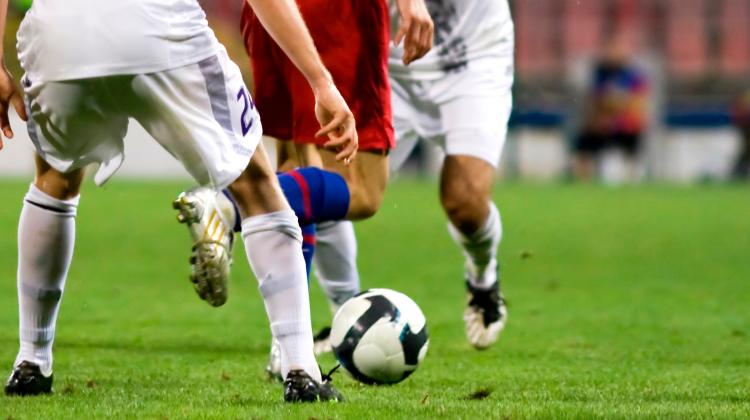Scientific approach to football can help achieve success, says expert
 Credit: Adobe Stock
Credit: Adobe Stock
The score in football is the result of many factors, including meteorological and climatic conditions. Dr. Marek Konefał studies the impact of the latter on football players. 'Maybe in 4-5 years the norm will be that coaching staffs will have specialists who will tell players how to prepare for the game in given conditions,’ he says.
The ambient temperature, humidity and other meteorological factors in which training sessions are held and football matches played should be taken into account by coaching staffs to predict players' performance and use appropriate playing strategies.
Dr. Konefał, a professor at the Wroclaw University of Health and Sport Sciences, has been analysing the game of football for years. He deals with modelling various - motor and technical and tactical - actions of football players in the context of the game result. 'And because climate factors and other external conditions affect these aspects, they are also of interest to me,’ he tells PAP.
He started his research with the 2014 World Cup in Brazil, where humidity and temperatures were very high, which was a real challenge for footballers from climatic zones such as in Poland. The next championship - Russia 2018 - was associated with yet another problem: the movement of players between training centres and match venues located in different environmental conditions. The aspect of the influence of meteorology on football performance returned in the Qatar World Cup research. Currently, Dr. Konefał works at the Climate Research Department of the Institute of Geography and Spatial Organization of the Polish Academy of Sciences, where climate specialists introduce him to the nuances that he can transfer to sports.
'I learned from them, for example, how important in football are not only humidity, air temperature, wind and sunlight, but also dew point temperature, universal thermal climate index (UTCI) and clothing,’ he says.
'During the World Cup in Russia, for example, we saw that those teams that moved in time zones from east to west scored significantly higher in the tournament. The teams that had training centres and played their matches in the same time zones also had better results.’
Konefał adds that the score in football is a result component of many factors in various areas. 'They all translate into specific parameters that determine the performance of the players. The first group consists of motor parameters, i.e. physical activity, distances covered, running intensity, braking, acceleration, turns during the run. The next group includes technical factors: passing, scoring goals, dribbling, possession of the ball. In the third group we have tactical parameters, and the last group is the mental area. Together they determine the result.
‘Meteorological conditions, including temperature and humidity, affect all these parameters. In a word: the climate does not directly affect the result, but it does affect the parameters that serve to achieve the result.
'For example, when a player is playing in a more demanding environment, he is less capable motorically but more technically active because he has to make more passes. His performance parameters are more affected, but his speed parameters - not so much. Interestingly, this speed, according to our findings, does not decrease as strongly as other parameters.’
He adds that his latest experiment showed that in more difficult conditions, footballers also enter the faster and more efficient reaction mode.
Ideally, Konefał says: ‘One would study all this in the game, but since this is not yet fully possible, analyses and tests are performed before and after training or a match, or - as was the case with the Qatar World Cup project - in special climate chambers. They simulate temperature, humidity and wind characteristic of a given climate. But it is no longer a real match in a real environment.
'In addition to broadly understood biochemistry and physiology, we also study the players' reaction time, which changes under the influence of fatigue, heart rate, lactate concentration, vo2max, ventilation, serotonin, etc. Many parameters affect performance.’
The results of such research can be used to design tailored training programs. Their goal would be to increase players' physiological adaptation by simulating specific game conditions. According to the researcher, proper preparation, based on the latest scientific knowledge and taking into account all factors, can help players maintain or even increase high and very high-intensity activity during games. This is particularly important in the case of tournaments held in extremely different climatic conditions, but - as the researchers emphasize - it also becomes more important in the face of global warming and the resulting heat-related health risks. Those are especially severe during sporting events.
During the 2014 FIFA World Cup, for example, Brazil's climate became a major concern for many European football teams. Under heat stress, the athletes' repetitive sprints and jumps were attenuated compared to moderate conditions. This effect occurred despite evidence that athletes adapt their physical activity patterns to hot weather (e.g. by reducing total and intense running distance) in order to maintain the intermittent sprinting effort ability required at key moments during a game. Previous research has also shown that athletes competing in temperatures above 28 degrees C experience 'heat stress' and reduce high-intensity activity and sprint efforts.
'In Poland, we are the only ones to conduct such research. There are no specialists in this field. However, we can see that our coaches are slowly becoming interested in this aspect of football,’ says Dr. Konefał. 'Before the Qatar World Cup, coach Czesław Michniewicz's staff invited Professor Jan Chmura, Dr. Paweł Chmura and I to a training camp. The desire to use science is growing, but there is still a problem with its efficient implementation.’
The expert believes that the issue he is studying is only just beginning to gain traction. 'We are discovering more and more of the building blocks that affect players. Maybe in 4-5 years it will be the norm that the coaching staffs of all teams will have specialists who will tell players how to prepare for the game in given conditions. Such topics are already consulted in some places.
'The truth is that a lot of performance gains would come from acclimatizing players to the new conditions. But it must be done in a specific, scientifically proven manner. Only then will it be effective, and disturbances caused by changes in climatic conditions will be eliminated', concludes the researcher from the Wroclaw University of Health and Sport Sciences.
Knowing the results of scientific research allows coaches not only to better acclimate, but also to use the right tactics that change depending on climatic and time zones. This includes both the tactics of the game itself and the tactics of substitutions during the game, which allows to adjust the pace of the game. In addition, there is proper nutrition, hydration before and during the game, and preparations.
'The factor of playing at home and away, which is so often mentioned, is just as important as the factor of playing in worse or better environmental conditions,’ says Dr. Konefał. 'What we do, which is factoring the game, is an extremely important aspect. Our research shows how to model the game to win. And that's what it's all about.’
Read more about Dr. Konefał's research here, here, here, here, here, here, here and here.
PAP - Science in Poland, Katarzyna Czechowicz
kap/ agt/
tr. RL
Przed dodaniem komentarza prosimy o zapoznanie z Regulaminem forum serwisu Nauka w Polsce.

















